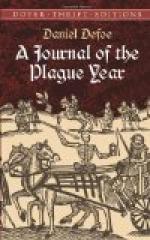My friend Dr. Heath was of opinion that it might be known by the smell of their breath; but then, as he said, who durst smell to that breath for his information, since to know it he must draw the stench of the plague up into his own brain in order to distinguish the smell? I have heard it was the opinion of others that it might be distinguished by the party’s breathing upon a piece of glass, where, the breath condensing, there might living creatures be seen by a microscope, of strange, monstrous, and frightful shapes, such as dragons, snakes, serpents, and devils, horrible to behold. But this I very much question the truth of, and we had no microscopes at that time, as I remember, to make the experiment with.[273]
It was the opinion, also, of another learned man that the breath of such a person would poison and instantly kill a bird, not only a small bird, but even a cock or hen; and that, if it did not immediately kill the latter, it would cause them to be roupy,[274] as they call it; particularly that, if they had laid any eggs at that time, they would be all rotten. But those are opinions which I never found supported by any experiments, or heard of others that had seen it,[275] so I leave them as I find them, only with this remark, namely, that I think the probabilities are very strong for them.
Some have proposed that such persons should breathe hard upon warm water, and that they would leave an unusual scum upon it, or upon several other things, especially such as are of a glutinous substance, and are apt to receive a scum, and support it.
But, from the whole, I found that the nature of this contagion was such that it was impossible to discover it at all, or to prevent it spreading from one to another by any human skill.
Here was indeed one difficulty, which I could never thoroughly get over to this time, and which there is but one way of answering that I know of, and it is this; viz., the first person that died of the plague was on December 20th, or thereabouts, 1664, and in or about Longacre: whence the first person had the infection was generally said to be from a parcel of silks imported from Holland, and first opened in that house.
But after this we heard no more of any person dying of the plague, or of the distemper being in that place, till the 9th of February, which was about seven weeks after, and then one more was buried out of the same house. Then it was hushed, and we were perfectly easy as to the public for a great while; for there were no more entered in the weekly bill to be dead of the plague till the 22d of April, when there were two more buried, not out of the same house, but out of the same street; and, as near as I can remember, it was out of the next house to the first. This was nine weeks asunder; and after this we had no more till a fortnight, and then it broke out in several streets, and spread every way. Now, the question seems to lie thus: Where lay the seeds of the infection all this while? how came it to stop so long, and not stop any longer? Either the distemper did not come immediately by contagion from body to body, or, if it did, then a body may be capable to continue infected, without the disease discovering itself, many days, nay, weeks together; even not a quarantine[276] of days only, but a soixantine,[277]—not only forty days, but sixty days, or longer.




